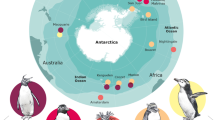Abstract
The northern Pacific seastar Asterias amurensis Lütken was recently introduced to Tasmanian waters, possibly through ballast water discharged from ocean-going vessels. Three Tasmanian populations and seven native populations from Japan and eastern Russia were examined in 1994 for variation at 22 allozyme loci. There was significant spatial heterogeneity in gene frequencies among the native populations, especially for the ocus APK *, where G ST was a very high 0.47. The Tasmanian populations could not be separated genetically from one another, suggesting they have a common origin from a single introduction. The average heterozygosity per locus of the Tasmanian populations (0.116 to 0.127, mean 0.123) was ∼30 to 40% less than that of the native populations (0.177 to 0.216, mean 0.192), suggesting that colonisation of Tasmanian waters was accompanied by a population-size bottle-neck. The Tasmanian seastars were genetically more closely related to the two populations from central Japan (Suruga and Tokyo Bays) than to populations from Vladivostok, northern Japan (Yoichi, Nemuro and Mutsu Bays) or southern Japan (Ariake Sea). However, there were significant differences between the populations from Tasmania and central Japan, which may be attributable to founder effects or may mean that the true source of the Tasmanian introduction has yet to be identified.
Similar content being viewed by others
References
Benzie JAH, Stoddart JA (1992) Genetic structure of outbreaking and non-outbreaking crown-of-thorns starfish (Acanthaster planci) populations of the Great Barrier Reef. Mar Biol 112: 119–130
Boileau MG, Hebert PDN (1993) Genetics of the zebra mussel (Dreissena polymorpha) in populations from the Great Lakes region and Europe. In: Nalepa TF, Schloesser D (eds) Zebra mussels: biology, impacts and control. Lewis Publishers, Ann Arbor, Michigan, pp 227–238
Bruce BD, Sutton CA, Lyne V (1995) Laboratory and field studies of the larval distribution and duration of the introduced seastar Asterias amurensis with updated and improved prediction of the species spread based on a larval dispersal model. Final Report. Fisheries Research and Development Corporation, Deakin, ACT, Australia
Carlton JT, Geller JB (1993) Ecological roulette: the global transport of nonindigenous marine organisms. Science, NY 261: 78–82
Chakraborty R, Nei M (1977) Bottleneck effects on average heterozygosity and genetic distance with the stepwise mutation model. Evolution 31: 347–356
Hebert PDN, Beaton MJ (1989) Methodologies for allozyme analysis using cellulose acetate electrophoresis. Helena Laboratories, Beaumont, Texas
Hoagland KE (1985) Genetic relationships between one British and several North American populations of Crepidula fornicata based on allozyme studies. J mollusc Stud 51: 177–182
Johnson D (1994) Seastar fight gains momentum. Aust Fish 53(1): 25–27
Jones MM (1991) Marine organisms transported in ballast water: a review of the Australian scientific position. Bull Bur rur Resour, Canberra 11: 1–48
Kasyanov VL (1988) Reproductive strategies of seastars in the Sea of Japan. In: Burke RD, Mladenov PV, Lambert P, Parsley RL (eds) Echinoderm biology. 1st edn. AA Balkema, Rotterdam, pp 205–209
Kerr S (1994) Ballast water ports and shipping study. Australian Quarantine and Inspection Service Report No. 5. Australian Government Publishing Service, Canberra
Knight AJ, Hughes RN, Ward RD (1987) A striking example of the founder effect in the mollusc Littorina saxatilis. Biol J Linn Soc 32: 417–426
Manchenko GP (1986) Electrophoretic estimation of the level of intraspecific genetic variability in seastars from the Sea of Japan. Biol Morya, Vladivostok 6: 43–52 [in Russ]
Matsuoka N, Fukuda K, Yoshida K, Sugawara M, Inamori M (1994) Biochemical systematics of five asteroids of the family Asteriidae based on allozyme variation. Zool Sci 11: 343–349
Nei M (1973) Analysis of gene diversity in subdivided populations. Proc natn Acad Sci USA 70: 3321–3323
Nei M (1978) Estimation of average heterozygosity and genetic distance from a small number of individuals. Genetics, Austin Tex 89: 583–590
Nei M, Maruyama T, Chakraborty R (1975) The bottleneck effect and genetic variability in populations. Evolution 29: 1–10
Nojima S, Soliman FE, Kondo Y, Kuwano Y, Nasu K, Kitajima C (1986) Some notes on the outbreak of the sea star, Asterias amurensis versicolor Sladen, in the Ariake Sea western Kyushu. Publs Amakusa mar biol Lab 8: 89–112
Roff DA, Bentzen P (1989) The statistical analysis of mitochondrial DNA polymorphisms: χ2 and the problem of small samples. Molec Biol Evolut 6: 539–545
Rogers JS (1972) Measures of genetic similarity and genetic distance. Univ Texas Publs 7213: 145–153 (Stud Genet VII)
Sagara JI, Ino T (1954) The optimum temperature and specific gravity for bipinnaria and young of Japanese starfish, Asterias amurensis Lütken. Bull Jap Soc scient Fish 20: 689–693
Swofford DL, Selander RB (1989) BIOSYS-1: a computer program for the analysis of allelic variation in population genetics and biochemical systematics. Release 1.7. Illinois Natural History Survey, Champaign, USA
Turner E (1992) A northern Pacific seastar, Asterias amurensis, in Tasmania. Aust mar Sci 120: 18–19
Williams RJ, Griffiths FB, van der Wal EJ, Kelly J (1988) Cargo vessel ballast water as a vector for the transport of non-indigenous marine species. Estuar cstl, Shelf Sci 26: 409–420
Woodruff DS, McMeekin LL, Mulvey M, Carpenter MP (1986) Population genetics of Crepidula onyx: variation in a Californian slipper snail recently established in China. Veliger 29: 53–63
Author information
Authors and Affiliations
Additional information
Communicated by G.F. Humphrey, Sydney
Rights and permissions
About this article
Cite this article
Ward, R.D., Andrew, J. Population genetics of the northern Pacific seastar Asterias amurensis (Echinodermata: Asteriidae): allozyme differentiation among Japanese, Russian, and recently introduced Tasmanian populations. Marine Biology 124, 99–109 (1995). https://doi.org/10.1007/BF00349151
Received:
Accepted:
Issue Date:
DOI: https://doi.org/10.1007/BF00349151




